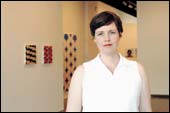
Alumni Newsmakers | Living Life “The Right Way” | The Art of Vision | In Memoriam | Artists’ Quarter |
The Language of Care | Alumni Bookshelf
The Art of Vision
 |
Photo by: Claire Duggan
|
Fusebox, a contemporary art gallery in Washington, is a reflection of the ideas and ideals of its owners. The open, refreshing, minimalist space invites lingering and conversation, and that’s the point.
Sarah Finlay, MA ’01, and her husband, Patrick Murcia, have spent years refining their vision: a gallery where the focus is presenting forward-thinking artists and their works, where open artistic dialogue is encouraged, and where a diverse audience is welcomed and engaged.
“We’ve been really lucky to have so much support—from both the existing arts community as well as a new generation of people interested in visual art,” says Finlay, who shares owner and director duties with Murcia. “It’s gratifying to reach out to a new arts base, to get people interested in supporting the arts.”
It’s not just D.C. residents who take an interest in Fusebox, which opened in 2001. Finlay and Murcia, who represent 18 artists, have groomed Fusebox to be a viable member of the global arts scene by participating in international arts fairs, attracting established and new collectors, and selecting artists whom they feel continually forge new ground.
Finlay, who was raised in the D.C. area and studied at American University and GW, says the success they have achieved is due in part to their surroundings.
“I’ve always appreciated what an international community Washington is. It is a cosmopolitan city that is very much aware of the rest of the world, and I wanted the gallery to reflect that,” Finlay says. “We are part of the broader, global dialogue, not just living in some sort of vacuum here in Washington; that’s certainly not the way the rest of the city operates.”
The efforts have paid off. Fusebox has garnered international attention as a vanguard gallery, being selected for exclusive fairs, gaining loyal audiences, and helping to launch the careers of innovative artists. The space transforms itself with each new installation, displaying everything from rooms filled with video projectors to walls covered floor to ceiling with newspapers.
During the year and a half it took for Finlay and Murcia to find the perfect space, they honed their ideas and presentation.
“We spent that planning time really thinking through our mission, what we wanted our gallery to represent,” Finlay says. “It was difficult, but by the time our doors opened, we were so focused and our message was so clear, and I think people got that message and understood what we were trying to do. And that was incredibly rewarding.”
For Finlay, the rewards of working in the art world are grounded in history and learning.
After earning a history degree from American University, she earned her master of arts degree in art history at GW. Her interest in the historical and cultural contexts of artwork, as well as her teaching experience, shapes the gallery’s presentations today.
“I was a teaching assistant at GW, and it was a great experience for me,” Finlay says. “I had wonderful support from the faculty. Having to explain concepts to college students helped me to break things down for myself.
“We always focus on our role as educators here, we focus on educating the audience, and my experience at GW to that end was invaluable.”
Finlay’s emphasis on learning and growth is apparent at exhibition openings. Upon arrival, guests are presented with essays that are themselves visual and verbal works of art that include photographs of the work and rich, informative descriptions of the artist, the exhibit, and his or her message. After reading the essays, discussing the works with the friendly and knowledgeable staff, and spending time with the pieces, everyone from the first-time visitor to the lifelong aficionado has enough information to begin forming his or her own impressions. And some begin collecting.
“It’s so rewarding to hear that someone is making their first purchase,” Finlay says. “They really become engaged, you can see it in their faces. They come back and they bring friends.”
As word of mouth continues to spread and the unique works continue to garner attention, the Fusebox staff seeks to maintain a friendly, professional atmosphere for all visitors.
“Sometimes people are intimidated by art, and I have to remind myself of that,” Finlay says. “There are so many clichés of the snobby art gallery person who doesn’t want to speak to you. We try to make everyone comfortable enough to ask questions, to find something in the gallery that is relevant, something that speaks to their experience of the world and draws them in.”
—Laura Ewald
Back to top | Fall 2003 Table of Contents
|